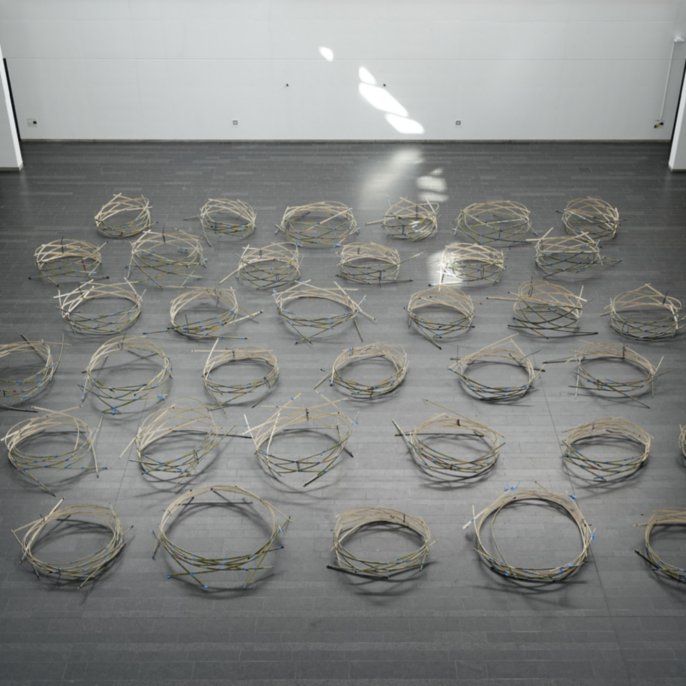Photographs by ITKE, University of Stuttgart und EPFL
BamX! Pavilion
Geometric Computing Laboratory, Alison Martin, Institute of Building Structures and Structural Design, Laboratory for Creative Computation
BamX! is a computationally designed bamboo structure. Raw bamboo slats are connected into deployable cylindrical elements that can be highly compacted for transport and storage. These cylinders are then joined seamlessly at carefully optimized woven nodes, creating a bending-active structural frame that is strong, yet extremely lightweight. The result is a continuous network of geometric curves that delineate a porous interior space. BamX! exemplifies how a symbiosis of refined weaving craft and advanced computational modelling enables fascinating new opportunities for sustainable design in architecture.
Bamboo
Bamboo is one of the fastest-growing plants in the world, offering unique opportunities for sustainable design. With a high strength-to-weight ratio, bamboo has been employed for centuries in architectural constructions. Our research aims to highlight how a combination of traditional weaving craft and advanced algorithmic design optimization enables new structural forms constructed from this fascinating natural material.
All bamboo poles used in the construction of BamX! have been naturally grown and harvested in the garden of Alison Martin shown in the image above. No fertilizers, pesticides or any other chemicals have been used. The bamboo of BamX! is used in its raw natural form, without any chemical or other treatment.
X-Shells
X-Shells are a new structural system for deployable grid shells recently developed at the Geometric Computing Laboratory of EPFL. Based on a scissor linkage mechanism, an X-shell is designed to deploy from a simple, compact state towards a carefully controlled 3D target shape. Slender beam elements bend and twist in the linkage to assume a static equilibrium state that minimizes internal stresses. Physics-based simulation and advanced numerical optimization facilitate the design of intricate freeform surfaces that can be deployed without the need for support or scaffolding.
These computational tools have been developed with homogeneous and isotropic materials in mind that have predictable mechanical behaviour. Raw bamboo, however, as a naturally grown, highly inhomogeneous and anisotropic material is difficult to model in numerical optimizations. To address this challenge, we rely on geometry as the universal language of form. Specifically, we study a new class of deployable cylindrical structures that can be connected at woven nodes to form stable, yet lightweight structures.
Geometry
The shape of the BamX! pavilion models part of a truncated icosahedron, a highly symmetric Archimedean solid. The final design is composed of 36 deployable cylinders that are connected at 21 woven nodes to form an arrangement of pentagons and hexagons. The mix of different polygonal elements in the structure locally breaks the symmetry and requires optimizing the nodes carefully to accommodate the different angles at which cylinders join at the node.
Weaving
Basket weaving is a traditional craft widely employed in many cultures across the world. Interleaving thin, flexible ribbons in carefully arranged patterns allows the creation of a variety of three-dimensional forms. The shape of a woven object is the result of the ribbon topology and the balancing of bending and twisting of ribbons. Building on the extensive experience and research of weaving artist Alison Martin, we extend concepts from the traditional craft of basket weaving by exploring new topologies and by carefully simulating the physical behaviour of the bamboo ribbons. Our predictive simulations allow us to optimize the ribbon pattern to achieve the desired woven form while minimizing the mechanical stress experienced by the ribbons.
Optimization
The BamX! pavilion is composed of cylindrical deployable X-shells that meet at woven node connections to form a globally coupled, bending-active system. To find the optimal topology and geometry of the pavilion, we employ advanced numerical optimization techniques that incorporate a physics-based simulation of the bending and twisting behaviour of the bamboo ribbons. The goal is to find the optimal ribbon crossing locations such that all external and internal forces are in a global balance, while the mechanical stress experienced by each ribbon is minimized.
Analysis
The method of integrating structural information into the design loop includes material evaluation and characterization, structure system characterization, and multi-scale structural analysis. Multi-scale calibration plays an important role in the structural understanding of the project, especially with the use of naturally grown materials and innovative methods of stabilizing global geometry through interlocking patterns. Calibrations are done on the component scale and the ribbon scale. Physical testing on the cylinder prototype informs the global design with an accumulated stiffness of the components. This data largely simplifies the initial FE analysis into a strut-represented model for rapid iterations on global topology. Once accomplishing the global topology optimization, the characterized mechanical properties from material samples allow for a more sophisticated simulation of the detailed woven geometry.
Design, Engineering and Fabrication Team
Geometric Computing Laboratory, EPFL
Filip Goc, Florin Isvoranu, Prof. Dr. Mark Pauly, Dr. Davide Pellis, Samara Ren, Dr. Seiichi Suzuki
Students: Ruben Bento, Antoine Brunner, Guillaume Hueber, Alix Magnaguémabé, Christian Meier, Sepehr Mousavi, Maximilian Paulsen, Xinran Tao, Sixiao Xu
Volunteers: James Pauly, Hannah Pauly
Weaver, Independent Researcher
Alison Martin
ITKE Institute of Building Structures and Structural Design, University of Stuttgart
Tzu-Ying Chen, Yanan Guo, Marta Gil Pérez, Prof. Dr. Jan Knippers
Laboratory for Creative Computation, EPFL
Eric Duong, Maxence Grangeot, Prof. Dr. Stefana Parascho, Ian Ting


